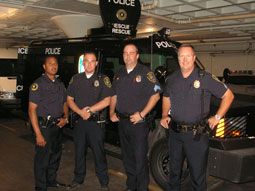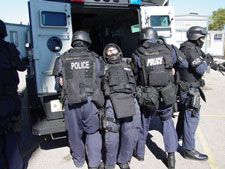By Chuck Remsberg, Police1 Senior Contributor
When you respond to a shots-fired call and find yourself pinned down by rifle rounds zinging in from an unidentified location, what’s the best thing you can see coming toward you?
For Matthew Seitz and David Sturma, Milwaukee (WI) PD officers caught in that spine-chilling predicament earlier this year, it was a formidable, black, no nonsense head-turner that looks something like a cross between a Humvee, an SUV, and a Brink’s truck.
“Our situation was scary as hell,” Seitz says. “The feeling of relief when you see that thing rumbling down the street toward you is hard to explain.”
“That thing” is technically called a Ballistic Engineered Armored Response Counter Attack Truck, shortened to BearCat by its manufacturer, Lenco Armored Vehicles in Massachusetts (www.swattrucks.com).
Pun aside, the BearCat is an arresting vehicle. Built on a Ford 4WD chassis, it’s constructed of nearly seamless hardened-steel armor plate and multi-hit ballistic glass, with blast-fragmentation-resistant floors, specially designed shooting ports and a rotating roof hatch. It can be used for firing chemical agents, Tasers, and firearms including machine guns and grenade launchers; has the stamina and durability to jump curbs and other obstacles; and can comfortably transport 10 fully geared officers for long distances.
| “We’re being shot at! We’re pinned down! Send help!” |
Once considered a desperation trump card for riot magnets like Los Angeles, BearCat-like equipment is now taking its place in the response arsenals not only of major heartland departments like Milwaukee (with more than 2,000 sworn personnel) but, through regional deployment, in medium-size and small towns as well.
A few years ago, having one available for a typical department would have seemed an exorbitant and pointless indulgence. But as violent events become pandemic and the versatility of armored vehicles becomes better appreciated, their presence on an agency’s wish list is starting to look as sensible as patrol rifles.
“The uses of these vehicles are only limited by your imagination,” says Sgt. Dan Wesolowski of Milwaukee’s Tactical Enforcement Unit. Wesolowski initiated his department’s acquisition of the BearCat through a federal Homeland Security grant after discussing the vehicle’s benefits with SWAT personnel from Lenexa, KS (pop. 42,000) at an NTOA conference. Although housed downtown in a parking garage under police headquarters, Milwaukee’s BearCat is available to departments throughout a 7-county region. Six other similar vehicles are scattered throughout the rest of the state.
After Milwaukee took delivery in May 2005, the BearCat was not called into service for about 5 months. Skeptical officers mocked it as a waste of money. Then since October when it was first deployed (at the scene of a particularly nasty barricaded EDP confrontation), the BearCat has rolled to 11 calls in the city, with its rate of use and appreciation for its capabilities steadily increasing. TEU Sgt. Jeffrey Kranz ticks off a sampling:
- • The BearCat is driven onto the front lawn of a house where a barricaded gunman is pumping a fusillade of 9mm rounds out of a window. From inside the vehicle, a well-protected negotiator is able to conduct face-to-face conversations with the offender via cell phone and the unit’s p.a. system.
• At another house barricade location, the BearCat drives up to a window, which is then broken out with a fireman’s tool manipulated from the hatch, allowing delivery of a throw phone. This leads eventually to the gunman’s peaceful surrender.
• The vehicle goes nose-to-nose with a Greyhound bus that has come to a halt on a freeway with a suicidal armed robber locked in the restroom. It then becomes the jumping off platform for a TEU team that enters the bus behind ballistic shields and brings the tense standoff to a halt.
 |
| (left to right) Ofc. Torrey Lea, Ofc. Matthew Seitz, Sgt. Jeffrey Kranz & Sgt. Dan Wesolowski, Milwaukee PD Tac Enforcement Team, in front of the BearCat |
“Sometimes just seeing this vehicle pull up causes less committed suspects to give up,” Kranz says. When presence alone doesn’t do the trick, the rolling fortress “makes the unapproachable approachable.” He also regards it as an effective tool to deploy at crowded protests, where officers on foot are often jeopardized and restricted by the sheer numbers of people surrounding them.
The rescue of Matt Seitz and Dave Sturma last winter ['06] was the first time the BearCat has been used in Milwaukee to save trapped officers.
Seitz and Sturma, members of a district-level gang unit, were on marked patrol in one of the city’s most “challenged” neighborhoods on a cold Saturday night when they responded to a shots-fired call phoned in from a fire station. They were sitting in their unit in the station’s driveway talking to a fire captain when new shots suddenly rang out-"Boom!! Boom!! LOUD!” Seitz recalls. “It sounded like someone was right behind our back bumper with a rifle.”
The captain ran back into the station. The officers bailed for cover, Sturma behind the car’s engine block and Seitz behind a brick column a few steps away. “We could hear rounds hitting the pavement,” but they couldn’t pinpoint the shooter’s location, Seitz says. “I thought the minute I stuck my head out I’d get shot at again. There was no way we could safely retreat.”
 |
| Training with the BearCat |
What he hadn’t noticed in his dive for cover was the station’s gasoline pump standing right in front of the column he was hiding behind. “Tunnel vision,” he laughs. “I didn’t even see it, and I thought I was being as tactically sound as possible.”
Sturma was on the radio: “We’re being shot at! We’re pinned down! Send help!”
The minute he heard the radio call, Ofcr. Torrey Lea, one of a dozen TEU members spread out through the city that night, headed instinctively for the BearCat at the headquarters garage. There had been threats in the neighborhood to kill a police officer, and with 2 officers now pinned down, there was no doubt the situation was urgent. When the vehicle hit the street, “the air horn cleared a path” straight to the scene some 3 miles away, Lea says.
Using a restricted channel, he was able to talk to Seitz and determine exactly where the officers were located, although the origin of the shots was still unknown. Lea paused briefly at a CP quickly established by Sgt. Kranz near the scene and picked up 2 TEU officers, Lane Grady and Javier Cornejo. From the back of the BearCat they would provide a physical rescue in case Seitz or Sturma was injured.
Then Lea drove directly into the kill zone to get them. “I was able to get ridiculously close,” he says. “I got the back doors of the BearCat within a foot of them.” The officers scrambled in and made their escape.
Elapsed time from the shots fired report to the rescue of the officers uninjured: 13 minutes. “They couldn’t have gotten there any sooner,” says Seitz, “but, boy, were we glad when they did!”
A short time later, the armored vehicle was driven back into the kill zone with lights blazing and siren wailing to act as a diversion while TEU members spread on foot into yards along the street to search for the mystery gunman and his lair. Neither the suspect nor his or her weapon was ever found.
Before this incident, Seitz had applied for transfer to the TEU. Afterward, he was brought on board and, like the rest of the TEU, is now fully trained to man the vehicle that may have saved his life.
What tips do Milwaukee’s BearCat fans offer officers from other agencies who may have access to such equipment? Here are a few things they say experience has taught them:
- 1. To maximize community acceptance, portray the BearCat only as an armored rescue vehicle, not as a “tank” or “urban assault vehicle.” The hatch is a “rescue hatch,” not a “turret.” The word RESCUE is prominently painted on every side of Milwaukee’s BearCat in large white letters. In these sensitive times, “words are everything,” Wesolowski observes. “If you don’t sell it as a rescue tool, your administration may be afraid to pull it out of the garage.” And the rescue, incidentally, can be of civilians as well as police.
2. Don’t have it sit idle until you desperately need it. “When the clock is ticking and lead is pinging off the sides is not the time to learn the nuances of its operation,” Kranz points out. Just opening and closing the 300-lb. doors requires some practiced finesse. So does muzzle control when you’re firing shoulder weapons from the rescue hatch, so you don’t get hot brass down your shirt collar.
Incorporate the vehicle into live-fire training scenarios and “stage” it at potentially violent calls even if there’s no immediate intention of using it. This keeps personnel tuned up and makes the vehicle quickly available “in case something goes sideways,” Kranz advises.
3. Remember that “you can’t drive it like a police car,” Lea cautions. You need to handle it more like you’d imagine a fire truck would be driven, allowing for smoother steering, longer braking distances, wider curves, and slow responses by civilian motorists who may be paralyzed by the startling sight of it. “No rapid EVOC maneuvers,” Wesolowski warns.
4. Do not operate the BearCat on frozen bodies of water. If you work in deep-freeze areas, you may be accustomed to driving conventional police vehicles across iced-up rivers and lakes in cold weather, but even the thickest ice becomes a dicier driving base when you’re at the wheel of a 17,500-lb. armored monster.
5. Keep speeds under 65 mph. The unit can roll over at excessive speeds or on uneven surfaces, Lea says, adding that it has “about the same roll factor as a Jeep.” On gravel, there’s a fishtailing risk. So “drive conservatively.” This is not a pursuit vehicle.
6. Before you reach a rescue site, “unlock every opening,” Lea suggests. You can never be certain in advance what access point might be needed with no seconds to spare.
7. Be sure you’re wearing your tactical helmet whenever you’re inside the vehicle, to avoid painful head-bangs.
8. As with any other law enforcement equipment or tactical maneuver, “don’t get complacent, don’t get too comfortable,” Wesolowski stresses. As versatile and protective as the BearCat is, it’s certain to have its vulnerabilities. And there are bound to be offenders out there who will find them and do their damnedest to exploit them against you.
SHARE YOUR EXPERIENCE & TAC VEHICLE TIPS
Have you and your agency had experience with a BearCat or other armored vehicle? Do you have tips to share on their use and deployment? If so, please let us know by e-mailing us at mailbag@policeone.com
TRAIN ON A BEARCAT
A hands-on training session on officer/citizen rescues using the BearCat will be included in the 2006 Southeast Tactical Operations Seminar, sponsored by the Assn. of SWAT Personnel-Wisconsin and hosted by the Milwaukee County SO Oct. 3-5 in Milwaukee.
Also during this conference, Police1 columnist Jeff Chudwin, chief of the Olympia Fields (IL) PD and president of the Illinois Tactical Officers Assn., will speak on “Surviving Officer-Involved Shootings and the Aftermath.” For more information, email Tobie Weberg, ASP president, at: tweberg@milwcnty.com.












